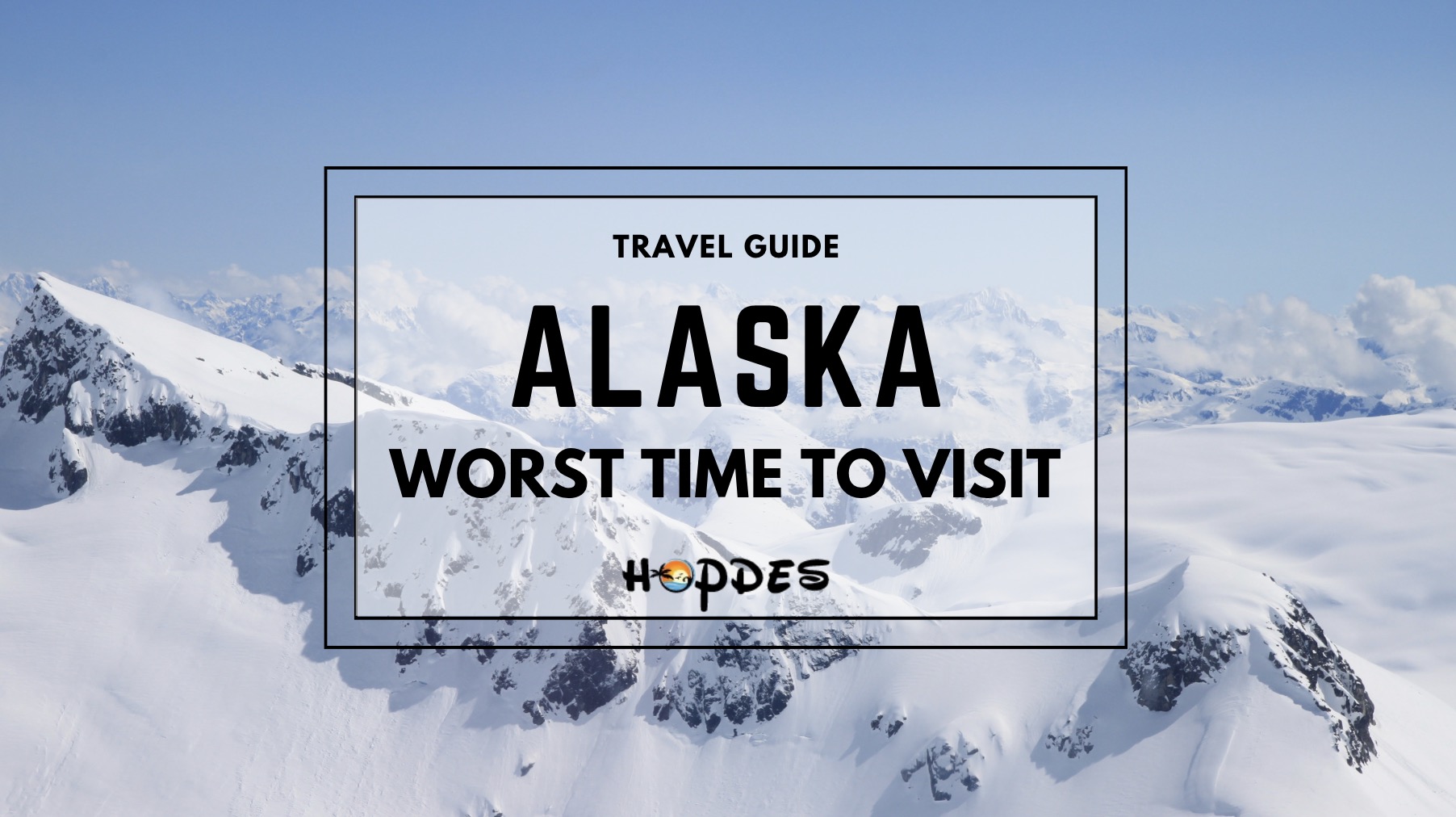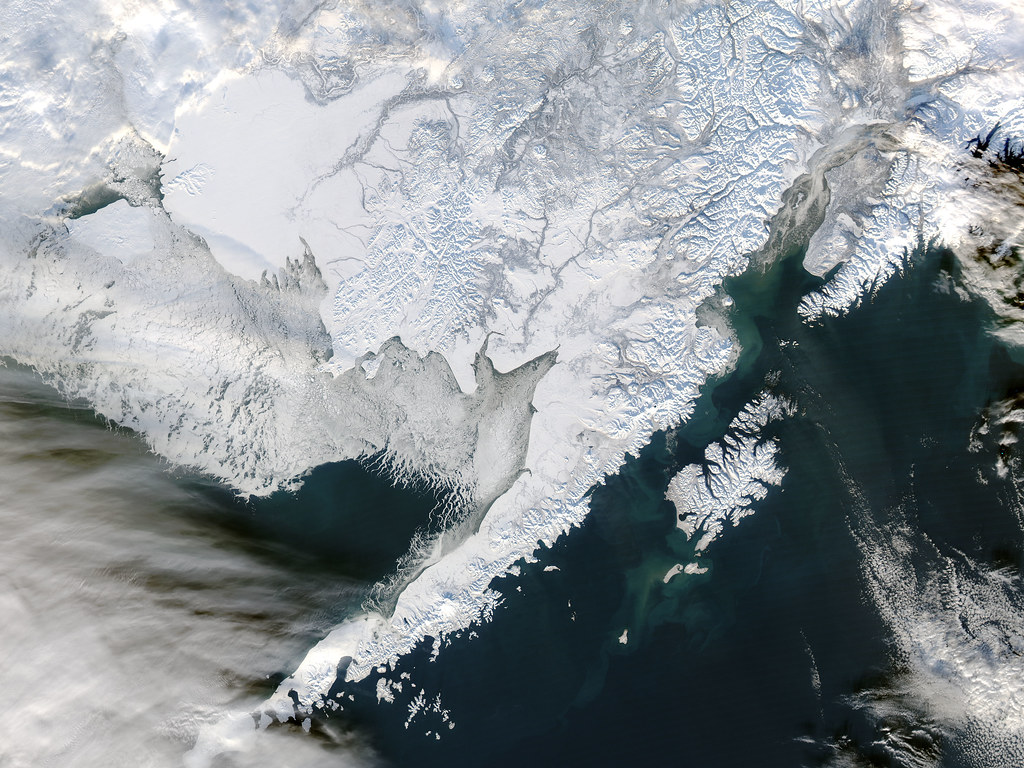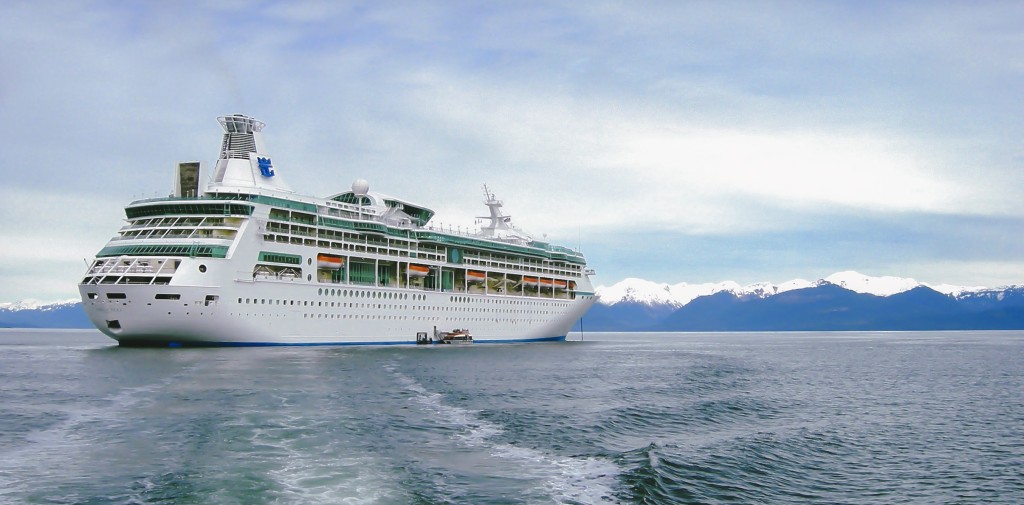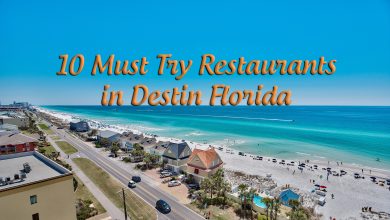
If you’ve got Alaska on your travel radar, you’re in for a wild ride – literally and figuratively. The Last Frontier boasts jaw-dropping landscapes and exhilarating escapades, but it’s also notorious for throwing some challenging weather and environmental curveballs your way.
So, before you pack your bags and head north, it’s vital to know when to go and when to, well, maybe reconsider. After all, Alaska can dish out the best of times or the worst of times, depending on when you roll into town. Stick around as we spill the beans on the not-so-ideal times to visit Alaska.
Worst Time To Visit Alaska
You should avoid planning your trip to Alaska between November and March because these winter months are usually not the best choice. Below are some important reasons why you should consider changing your travel plans for this period:
- Firstly, Alaska’s winter is known for its harsh conditions, including extremely low temperatures and heavy snowfall. Traveling during this season requires thorough preparation for extreme cold.
- Secondly, winter in Alaska brings significantly shorter daylight hours. The sun may only be visible for a few hours each day, which can severely limit your chances for sightseeing and exploration.
- Lastly, while skiing and snowboarding are still options, many other outdoor activities become more challenging due to adverse weather conditions. Hiking, wildlife viewing, and certain tours may be limited or even unavailable during this time.
![A-Z Guide to The Best Alaska Cruises [2023 Updated]](https://hopdes.com/wp-content/uploads/2023/04/Alaska-Mountains-Sky-e1681318557188-1024x563.jpg)
Suggested Reading: Worst Time to Visit Disney World According To Experts
Additional Challenges: Worst Time To Visit Alaska
While we’ve already discussed the major difficulties of touring Alaska in the winter, there are additional factors to ponder when deciding on the least suitable periods for your Alaskan expedition. Take a look below to investigate them.
Wildlife Hibernation
Winter can be a tricky time to visit Alaska, especially if you hope to spot a variety of wildlife. Many animals have special winter routines that make it challenging to see them. Curious why? Here’s the answer.

- Bears: Brown, black, and Kodiak bears usually go into hibernation from late October or November until March or April. While you might catch a glimpse of polar bears in specific places like the Kuskokwim Delta, St. Matthew Island, and St. Lawrence Island, they are rare and not easy to find.
- Marine mammals: Animals like sea lions, seals, sea otters, and whales are often seen near Alaska’s shores and in its offshore waters. However, some of these creatures also head to warmer or more bountiful waters during winter. For instance, humpback whales leave Alaska in late fall to give birth and return in the spring. Sea otters may also move to areas with less ice and more food during winter.
- Birds: Alaska is a haven for hundreds of bird species, but many of them fly south during winter. Ducks, geese, swans, cranes, shorebirds, warblers, and sparrows are among the birds that leave Alaska during this season. You might still spot ravens, chickadees, woodpeckers, and ptarmigans in winter, but they are not as diverse and abundant as they are in the summer.
Editor’s Pick: Worst Time to Visit Aruba According to Travel Experts
Snowstorm
Winter snowstorms in Alaska can add an adventurous twist to your trip, but they come with their own set of challenges. When heavy snowfall blankets the region, visibility takes a significant hit and the roads become dangerously slippery. This can elevate the risk of accidents and lead to travel delays.

Further, some places and attractions (especially those in remote or mountainous areas) can become nearly inaccessible due to heavy snow. It means you might miss out on beautiful sights and experiences. Places like Denali National Park, where roads and trails can be buried under thick snow, or remote spots like the Arctic National Wildlife Refuge become nearly unreachable during harsh winter months.
Moreover, it can cause damage to essential services like heating, water, and sanitation. It has the power to block pipes, bring down power lines, and even cause roof collapses. These disruptions can lead to a lack of crucial services during your stay.
Even in March 2023, Anchorage experienced a record-breaking snowstorm. It dumped over two feet of snow in less than 24 hours, which broke a record that had been held since 1966 when 15.6 inches fell. This massive storm led to widespread power outages, school closures, flight cancellations, and even roof collapses. It created dangerous driving conditions and prompted a rare blizzard warning for the city.
Freezing Temperature
Alaska encounters diverse weather conditions, including extreme cold with a record low of −80°F (−62°C). This extreme cold isn’t just a minor inconvenience; it can seriously impact your visit. At night, temperatures can plunge below freezing, making getting around a significant challenge and even hazardous if you’re not well-prepared.

One of the most critical concerns in freezing temperatures is the risk of hypothermia and frostbite. These conditions can strike quickly in extreme cold and can even be life-threatening. If you start to feel any numbness in your fingers, toes, or other extremities, it’s crucial to seek shelter indoors or get into a warm vehicle immediately to prevent serious cold-related injuries.
For those looking forward to enjoying popular winter activities, the freezing temperatures can bring their own set of challenges. The cold can alter the snow’s texture, which makes it less fluffy and more crusty. This change can reduce traction and slow down skis, snowshoes, or snowmobiles.
Off Season
Traveling to Alaska during the off-season (which usually spans from late October to early April) also comes with its own set of difficulties. While it may appeal to those seeking to witness the Northern Lights, engage in winter sports, or avoid the crowds, it’s essential to consider one important drawback.
Mainly, during the off-season, you’ll find fewer deals and limited options for accommodations, activities, and transportation. Many businesses reduce their operations or close entirely, which can restrict your choices and lead to less availability.
However, if you decide to brave the off-season then don’t forget about the vibrant festivals like Fur Rondy and Iditarod, which can add a unique and exciting dimension to your Alaskan adventure.
Some Other Challenges
Similar to winter, summer in Alaska also has its challenges. However, they are generally less demanding compared to the difficulties of winter. With that perspective in mind, let’s turn our attention to these distinctive summer quirks and explore what they entail:
Rainfall
The late summer and early fall in Alaska (August) mark the rainy season with a total precipitation of 81.63mm according to weather reports. While it can still be a stunning time to visit, the frequent rainfall during this period can pose challenges. It may restrict certain outdoor activities and impact visibility for wildlife watching and sightseeing, potentially affecting the quality of your visit. June and July are also the months with heavy rainfall as the average precipitation during this time is 62.54mm and 52.95mm, respectively.

The following table summarizes the precipitation in Alaska over the year
| Precipitation in Alaska | ||
| Month | Precipitation (mm) | Precipitation (inches) |
| January | 9.02 | 0.36 |
| February | 11.78 | 0.46 |
| March | 22.07 | 0.87 |
| April | 24.87 | 0.98 |
| May | 23.27 | 0.92 |
| June | 62.54 | 2.46 |
| July | 52.95 | 2.08 |
| August | 81.63 | 3.21 |
| September | 38.25 | 1.51 |
| October | 25.33 | 1 |
| November | 17.67 | 0.7 |
| December | 9.83 | 0.39 |
Buggy Season
The bug season in Alaska, mainly from June to July, can pose challenges for visitors due to the thriving mosquito and insect populations. Alaska’s vast expanse of wetlands, extensive forests, and lowlands provide ideal breeding grounds for mosquitoes.

Furthermore, research by Lauren Culler reveals that the warmer climate in Alaska leads to faster mosquito growth and increased longevity.
During these warmer months, Alaska witnesses a significant surge in mosquito and insect activity, which can affect outdoor activities.
However, there are ways to mitigate these challenges. Visitors can opt for wearing clothing that covers their skin completely and applying mosquito repellent lotions. While these measures can help, it’s important to note that mosquitoes in Alaska can carry diseases such as dengue fever.
Editor’s Pick: Worst Time To Visit Miami According to Locals & Experts
When Alaska is Expensive and Crowded
Alaska can be a bit expensive and crowded during the busiest months, which start from June to August. According to the Resource Development Council, another peak season coincides with the operation of cruise ships in Alaska, which run from April through October. In fact, more than half of all visitors arrive on these cruise ships.

For example, in 2018, 1,169,000 people arrived by cruise, 760,100 flew in, and 97,200 came by road or ferry. However, here’s the catch: because so many people visit, prices for places to stay, transportation, and tours go up, and it can be tricky to get reservations.
So, if you want to avoid the big crowds and save some money, you might want to think about going in May (early season) or September (late season). During these times, you can get discounts of 10% to 25% on some hotels, tours, and cruises, and still enjoy Alaska’s natural beauty and adventure.
When to Visit Alaska?: Month-by-Month Guide
Follow this guide and plan at the right time to visit Alaska. Consider the important events that you want to attend, as well as the level of crowd and average temperatures.
January
- Temperatures: January is the coldest month in Alaska, with average temperatures ranging from -20°F to 20°F (-29°C to -6°C).
- Weather: Expect snowfall throughout the state, making it ideal for winter sports enthusiasts.
- Activities: Popular activities include dog sledding, ice fishing, skiing, and snowmobiling.
- Special Events: The start of the Iditarod Trail Sled Dog Race in Anchorage is a major event.
- Crowd Level: Generally low, except in Anchorage during the Iditarod.
February
- Temperatures: Similar to January, with cold temperatures ranging from -15°F to 20°F (-26°C to -6°C).
- Weather: Cold and snowy, perfect for winter adventures.
- Activities: Continue to enjoy winter sports and northern lights viewing.
- Special Events: The Fur Rendezvous Festival in Anchorage is a fun cultural event.
- Crowd Level: Low to moderate.
March
- Temperatures: Gradual warming, with average temperatures between 5°F to 30°F (-15°C to -1°C).
- Weather: Snow begins to melt, and daylight hours increase.
- Activities: Winter sports are still popular, and wildlife viewing begins.
- Special Events: The Iditarod race finishes in Nome, drawing crowds.
- Crowd Level: Moderate.
April
- Temperatures: Spring arrives, with temperatures ranging from 20°F to 45°F (-6°C to 7°C).
- Weather: Snow continues to melt, and the landscape becomes more accessible.
- Activities: Wildlife viewing, early-season hiking, and bird watching.
- Special Events: Spring festivals in some cities.
- Crowd Level: Moderate to low.
May
- Temperatures: Mild, with average temperatures of 40°F to 60°F (4°C to 15°C).
- Weather: Spring is in full swing, and the scenery is lush and green.
- Activities: Ideal for hiking, fishing, and exploring national parks.
- Special Events: Some towns have Memorial Day celebrations.
- Crowd Level: Moderate, increasing towards the end of May.
June
- Temperatures: Pleasant, ranging from 50°F to 70°F (10°C to 21°C).
- Weather: Summer begins with long daylight hours, making it great for outdoor activities.
- Activities: Hiking, wildlife cruises, fishing, and kayaking.
- Special Events: Summer solstice celebrations in some communities.
- Crowd Level: Moderate to high, especially in popular tourist spots.
July
- Temperatures: Warmest month, averaging 55°F to 75°F (13°C to 24°C).
- Weather: Peak of summer with lots of sunshine and mild evenings.
- Activities: All outdoor activities are in full swing, including camping and wildlife viewing.
- Special Events: Independence Day celebrations are a big deal across the state.
- Crowd Level: High, especially in tourist hotspots.
August
- Temperatures: Similar to July, ranging from 50°F to 70°F (10°C to 21°C).
- Weather: Late summer offers pleasant conditions for exploration.
- Activities: Continue with outdoor activities, and salmon fishing is excellent.
- Special Events: Local fairs and cultural festivals.
- Crowd Level: High, especially in popular destinations.
September
- Temperatures: Gradual cooling, averaging 40°F to 60°F (4°C to 15°C).
- Weather: Fall foliage begins, and it’s a great time for photography.
- Activities: Wildlife viewing, hiking, and berry picking.
- Special Events: Harvest festivals.
- Crowd Level: Moderate, decreasing as the month progresses.
October
- Temperatures: Cooling down, ranging from 30°F to 50°F (-1°C to 10°C).
- Weather: Fall colors are at their peak, but daylight hours decrease.
- Activities: Enjoy the autumn scenery, and prepare for winter.
- Special Events: Halloween festivities.
- Crowd Level: Low to moderate.
November
- Temperatures: Cold, with averages between 10°F to 30°F (-12°C to -1°C).
- Weather: Snowfall begins, and winter activities return.
- Activities: Winter sports, northern lights viewing, and early-season holiday shopping.
- Special Events: Thanksgiving celebrations.
- Crowd Level: Low to moderate.
December
- Temperatures: Winter sets in, with temperatures ranging from -10°F to 20°F (-23°C to -6°C).
- Weather: Snowy and cold, perfect for winter sports.
- Activities: Winter sports and festive holiday events.
- Special Events: Christmas and New Year’s celebrations.
- Crowd Level: Moderate, higher around the holidays.
Suggested Reading: Worst Time to Visit Arizona? hint.. it’s the Summer Season

Conclusion
While Alaska offers breathtaking landscapes and unique experiences year-round, it’s essential to carefully consider when to visit. The worst times to visit are during the harsh winter months from November to March when extreme cold, limited daylight, and adverse weather conditions can hinder outdoor activities and wildlife sightings. Additionally, visiting during peak summer months (June to August) can mean larger crowds and higher costs. The ideal times to explore Alaska depend on your preferences – for fewer crowds and milder weather, consider May, early June, or September. However, each season has its own charm and unique offerings for adventurous travelers.
Worst Time to Visit Alaska - FAQs
YES! Winter in Alaska, particularly from November to March, brings frigid temperatures and heavy snowfall, transforming the landscape into a stunning winter wonderland.
Yes, visiting Alaska during the off-season (late October to early April) can have its advantages. It’s a great time for witnessing the Northern Lights, engaging in winter sports, and avoiding crowds. However, be prepared for limited services and accommodations, as many businesses reduce their operations.
Traveling during Alaska’s worst times, particularly in winter, poses weather-related risks such as extreme cold, heavy snowfall, and icy road conditions. These conditions can lead to accidents, travel delays, and the risk of hypothermia and frostbite if not adequately prepared. Snowstorms can also disrupt services like heating and transportation.
 Reviewed by
Reviewed by 



